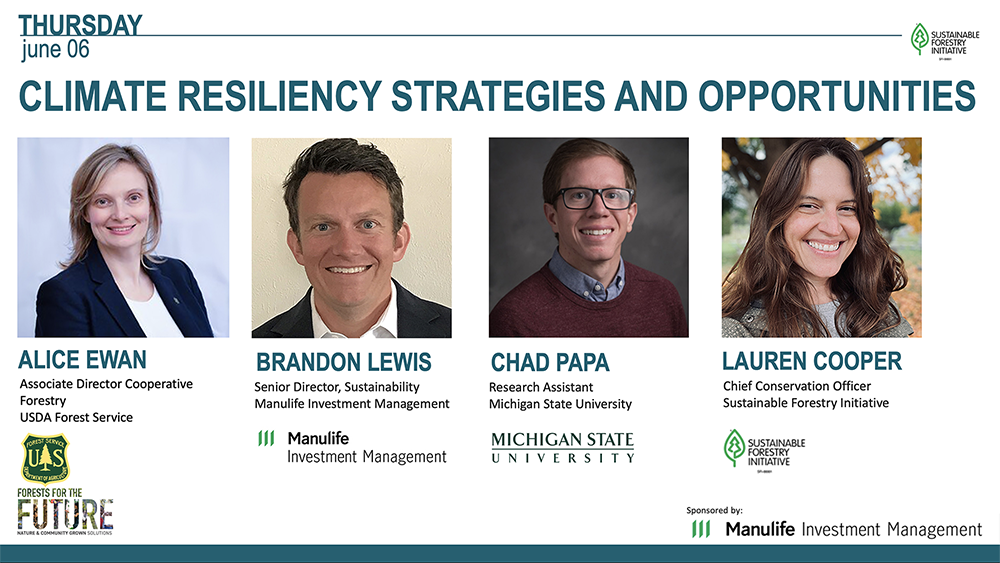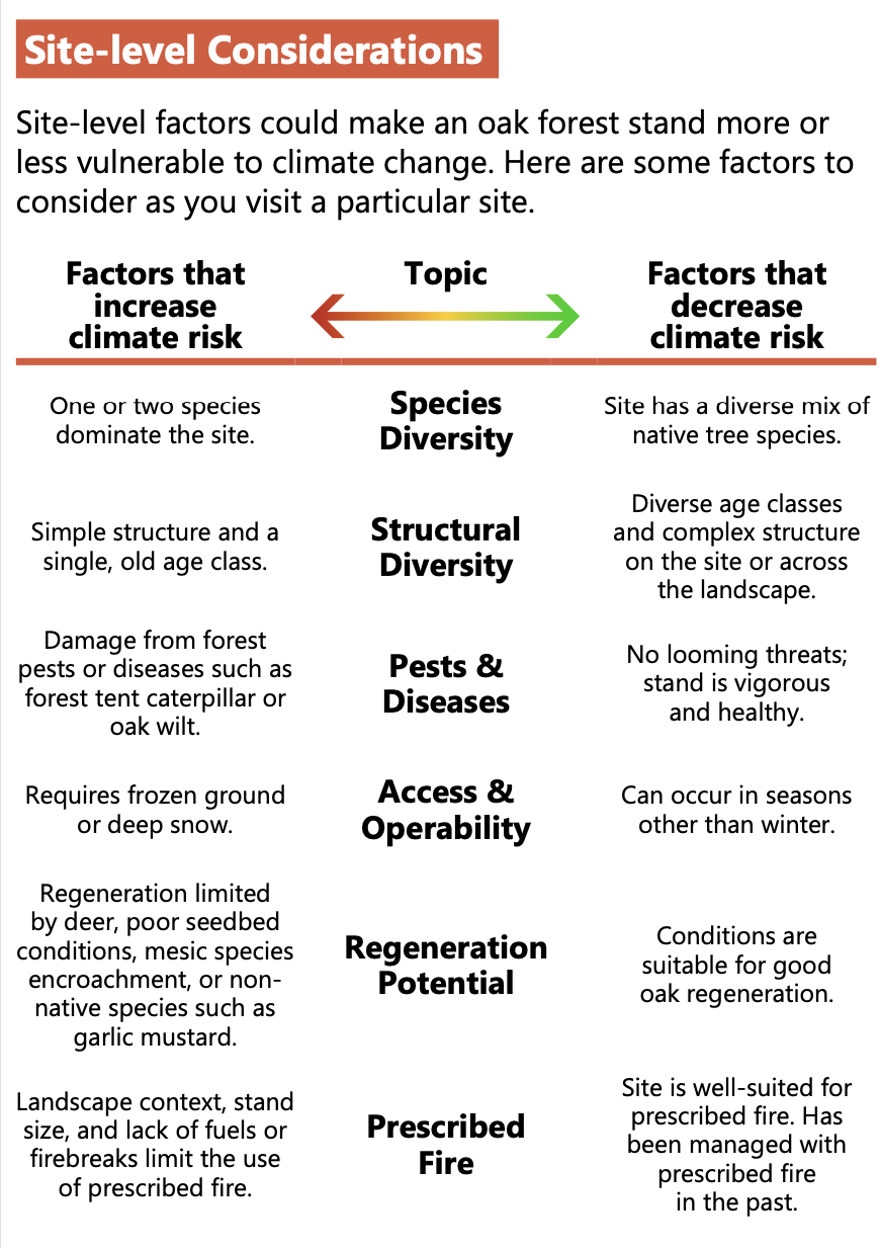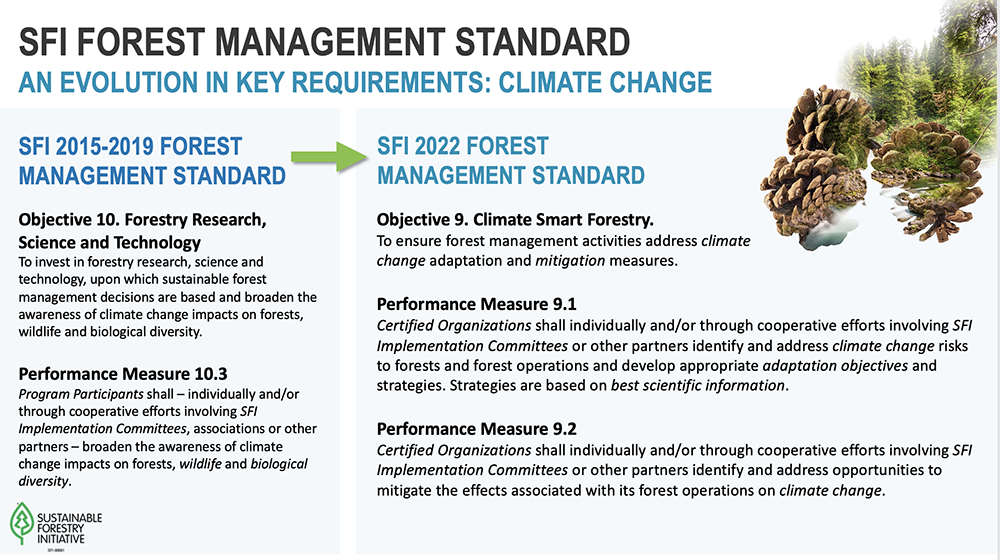By Lauren Cooper, Chief Conservation Officer at SFI
North American forests play a vital role in the fight against climate change. These vast ecosystems act as carbon sinks, absorbing significant amounts of atmospheric CO2. Ensuring the long-term health and sustainability of these forests requires closing the gap between the latest forest-climate research and ongoing efforts to interpret and implement climate-smart forest management practices.
This summer’s 2024 SFI Annual Conference featured a panel discussion called Climate Resiliency Strategies and Opportunities that focused attention on closing this gap between climate science and sustainable forest management in North America. I had the privilege of leading this panel discussion, which current efforts and focused on solutions for a more integrated approach between science and day-to-day forest management.
 My fellow panelists included representatives from the USDA Forest Service, Michigan State University, and Manulife Investment Management—an entity with SFI-certified forests. We discussed how the scientific community has a wealth of data on the impact of climate change on forests. We also agreed that this information often fails to translate effectively into practical sustainable forest management strategies. Foresters on the ground may lack the resources or training to identify and implement climate-resilient practices. Additionally, policy frameworks governing forest management may not adequately consider the latest climate science. This disconnect, between scientific knowledge and on-the-ground practices, hinders our ability to manage forests as sustainably as possible in a changing climate.
My fellow panelists included representatives from the USDA Forest Service, Michigan State University, and Manulife Investment Management—an entity with SFI-certified forests. We discussed how the scientific community has a wealth of data on the impact of climate change on forests. We also agreed that this information often fails to translate effectively into practical sustainable forest management strategies. Foresters on the ground may lack the resources or training to identify and implement climate-resilient practices. Additionally, policy frameworks governing forest management may not adequately consider the latest climate science. This disconnect, between scientific knowledge and on-the-ground practices, hinders our ability to manage forests as sustainably as possible in a changing climate.
Forest Certification as a Pathway to Climate-Smart Forestry
During the panel discussion, we explored how forest certification serves as a pathway to disseminate best practices and incentivize climate-smart forestry at scale for climate adaptation. We also learned how SFI‑certified organizations are working with SFI to conduct needs assessments. Chad Papa, a Research Assistant at Michigan State University, explained the importance of thorough, consistent application of a variety of stand- and site-level climate-smart forestry measures. Papa cited species diversity, structural diversity of the forest, and its regeneration potential as factors worth considering as part of climate-smart forestry included.

Developing Indicators and Best Management Practices to Deliver on the Promise of Climate-Smart Forestry
The climate-resiliency panel at the annual conference also highlighted some of the ways SFI is encouraging sustainable forestry to equip the people working in our forests with the climate-smart forestry tools and techniques they need to succeed. We looked at a range of big-picture themes such as water and species adaptation to consider what related climate tools and techniques would look like. This included:
Water: Changing larger culverts or bridge structures to accommodate higher peak flows and flood conditions, where ecologically appropriate with respect to the spread of native and invasive species
Fire: Changing road layout and design to resist washouts from floods, or to create systemic fire breaks
Forest management: Modifying harvest scheduling and locations to reduce climate impacts during shifting seasons (e.g., avoidance of wet spring conditions, with increased risks of rutting and losses to soil carbon)
Indigenous knowledge: Engaging Indigenous rights-holders, knowledge holders, and land-users to create a wider understanding of traditional land-use and stewardship practices, as well as the extent to which any form of ecosystem modification may be appropriate in a changing climate
Species adaptation: Assisting tree migration through selective planting to give preference to species that will thrive in anticipated future climate conditions, in a manner that avoids or minimizes adverse impacts to Indigenous peoples’ rights and traditional practices
Silviculture: Developing new climate-smart silvicultural techniques to accommodate altered growing conditions
USDA Forest Service: SFI is a Strategic Partner
 These emerging best management practices are all part of a larger effort at SFI to make sustainable forestry synonymous with climate-smart forestry. Alice Ewen, Assistant Director of Cooperative Forestry at the USDA Forest Service, described how historic investments from the Inflation Reduction Act and Bipartisan Infrastructure Law are enabling progress in climate-smart forestry management practices and broadening their reach in the forest.
These emerging best management practices are all part of a larger effort at SFI to make sustainable forestry synonymous with climate-smart forestry. Alice Ewen, Assistant Director of Cooperative Forestry at the USDA Forest Service, described how historic investments from the Inflation Reduction Act and Bipartisan Infrastructure Law are enabling progress in climate-smart forestry management practices and broadening their reach in the forest.
Ewen described SFI as a “strategic partner” when it comes to encouraging climate-smart forestry. She pointed to SFI’s ability to act as a forestry leader able to test, demonstrate, and help define climate-smart forest management. SFI’s focus on partnerships was named as a powerful way to reduce barriers for historically underserved landowners and Tribes in a new climate-smart economy. SFI annual survey results show about 50% of SFI‑certified organizations will be updating their management practices to meet new climate-smart requirements. The other 50% of SFI‑certified organizations are already implementing these kinds of practices.
Ewen is also optimistic about SFI’s ability to inform policymakers on the role of science-based, sustainable forest management in climate mitigation and adaptation. The SFI 2022 Standards and Rules introduced progressive new climate-related objectives in the SFI Forest Management Standard related to climate-smart forestry, fire resiliency, and awareness that have the potential to profoundly influence policy development.
SFI Certification Aligns with ESG Reporting Frameworks
Panelist Brandon Lewis, Senior Director of Sustainability at Manulife Investment Management, expanded on this theme and showed how SFI certification is not only influencing policymakers on climate: SFI is also helping the private sector align with climate-related ESG criteria. With the proliferation of ESG standards and regulations over the past few years, and in particular the advent of the EU’s sustainability finance taxonomy and Sustainable Finance Disclosure Regulations, forest certification continues to prove its relevance.
Lewis concluded by noting that SFI certification is a comprehensive mechanism for credibly demonstrating sustainable asset management and, critically, it provides independent assurance to stakeholders that Manulife is operating sustainably.
Building a Future Where Cutting-Edge Climate Science and Sustainable Forestry Go Hand-in-Hand
The climate-related discussions at the SFI Annual Conference left me feeling energized and hopeful. To see government representatives, foresters, scientists, and the private sector coming together to close the gap between what we know about climate-smart forestry and how we can make informed decisions on the ground points to a brighter future for our forests and all of us who depend on them.
Sources
Cooper, L., & MacFarlane, D. (2023). Climate-Smart Forestry: Promise and risks for forests, society, and climate. PLOS Climate, 2(6), e0000212.
Handler, S., T. Bishop, L. Cooper, J. Crick, M. Felde, D. Gadoth-Goodman, J. Hartman, A. Helman, A. Henriksen, T. Hobbs, R. Janowiak, K. Konen, B. O’Brion, T. Ontl, M. Peters, G. Peterson, K. Marcinkowski, K. Ross, B. Schram, M. Smalligan, M. Strieter, C. Young, and M. Janowiak. 2022. Climate change field guide for northern Michigan forests: Site-level considerations and adaptation. Northern Institute of Applied Climate Science (NIACS). Houghton, MI: U.S. Department of Agriculture, Northern Forests Climate Hub. 100p.
USDA. USDA Building Blocks for Climate Smart Agriculture and Forestry: Implementation Plan and Progress Report; United States Department of Agriculture: Washington, DC, USA, 2016.
